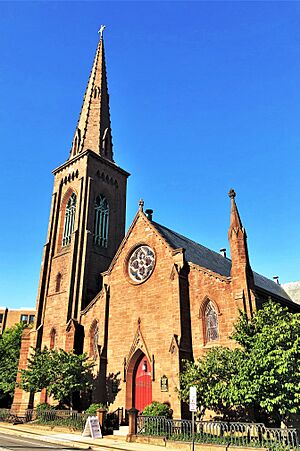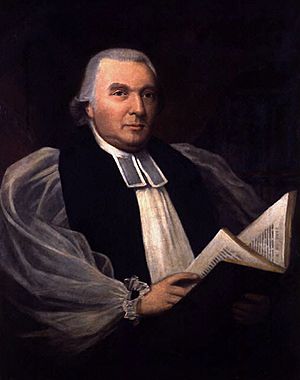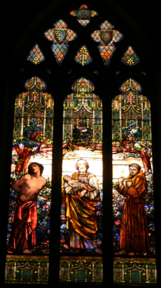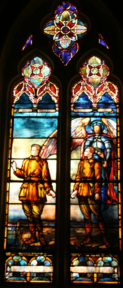St. James Episcopal Church (New London, Connecticut) facts for kids
Quick facts for kids St James Church |
|
|---|---|

(2022)
|
|
| 41°21.3′N 72°5.9′W / 41.3550°N 72.0983°W | |
| Country | United States |
| Denomination | Episcopal Church |
| Website | St James Church New London |
| History | |
| Status | Parish Church |
| Founded | June 6, 1725 |
| Dedication | James, son of Zebedee |
| Consecrated | June 11, 1850 |
| Events | Burned on September 6, 1781 during the Battle of Groton Heights |
| Past bishop(s) | Samuel Seabury |
| Architecture | |
| Heritage designation | National Register of Historic Places |
| Designated | July 21, 2004 |
| Architect(s) | Richard Upjohn |
| Style | Gothic Revival |
| Groundbreaking | November 3, 1847 |
| Construction cost | $60,000 |
| Specifications | |
| Materials | New Jersey Red Sandstone |
| Administration | |
| Deanery | Seabury |
| Diocese | Episcopal Diocese of Connecticut |
| Province | Province 1: New England |
St. James Episcopal Church is a historic church located in New London, Connecticut. It stands at 76 Federal Street, at the corner of Huntington Street. This church is part of the Episcopal Diocese of Connecticut.
The church community started way back in 1725. The building you see today is actually the third one built for the congregation. It was constructed between 1847 and 1850. The design is in the Gothic Revival style, created by a famous architect named Richard Upjohn.
Because of its important history and beautiful design, the building was added to the National Register of Historic Places in 2004.
Contents
History of St. James Church
The First Church Building
St. James Church was officially formed on June 6, 1725. Their first church building was made of wood and opened in 1732. It was located on New London's Parade.
An interesting story from that time involves a Native American chief. He shot an arrow into the golden ball at the very top of the church's steeple! The arrow stayed there until the church was destroyed in 1781.
During the American Revolution, some church members supported the British King. Because of this, church services stopped for a few years. In 1778, the church decided that only pastors who prayed for the American Congress could lead services.
Sadly, the first church was burned down on September 6, 1781. This happened during the Battle of Groton Heights, when British forces set fires in New London. The British commander was Brigadier General Benedict Arnold, who was from nearby Norwich.
Bishop Samuel Seabury's Role
Samuel Seabury (1729–1796) became a very important person for the Episcopal Church. He was consecrated as the first bishop of the Episcopal Church (United States) in Scotland on November 14, 1784.
Bishop Seabury returned to New London in 1785 and became the rector (head priest) of St. James. He passed away in New London on February 25, 1796. Today, he is buried in Hallam Chapel, which is located in the undercroft (a room below the main church) of St. James.
There is also a special monument, called a cenotaph, designed by architect Richard Upjohn, inside the church. Bishop Seabury's original grave slab is outside the church, covered by a copy.
The Second Church Building
A new church building was dedicated on September 20, 1787. This church was located near where the Salvation Army building is today in New London. This was the church where Bishop Seabury served.
As the church community grew in the mid-1800s, it became clear that they needed an even bigger building.
The Current Third Church Building
The church building you see today is the third one for the congregation. It was designed by the English-born architect Richard Upjohn. He designed it in the Gothic Revival style, which looks like old medieval churches.
The first stone for this building was laid on November 3, 1847. The church was officially opened on June 11, 1850. It was built in a "cruciform" style, meaning it has a cross shape with parts extending out to the north and south. There is also a very tall bell tower on the northwest side.
St. James is a great example of Upjohn's architectural work. It's interesting that St. James was started just one year after Upjohn finished designing the famous Trinity Church (Manhattan) in New York City.
The Rectory Building
The rectory, which is the home for the church's rector, is on Huntington Street. It's one of four Greek Revival style houses built between 1835 and 1845. These homes are known as Whale Oil Row.
This row of buildings is very special in Connecticut. It shows how wealthy people lived who worked in the whaling industry during that time.
Beautiful Stained Glass Windows
|
Lawrence Memorial Window by Tiffany Studios
Mansfield Memorial Window by J&R Lamb Studios
|
St. James Church has many beautiful stained glass windows. These windows tell stories and honor people.
Early Windows by Henry E. Sharp
The first stained glass windows, including the one behind the altar, were put in place in 1850. People believe they were designed by the Henry E. Sharp Studio in New York. Many of these original windows have been replaced over the years. However, some windows with a "grisaille" style (using shades of gray and white) are still there.
Amazing Louis Comfort Tiffany Windows
Starting in 1910, six of the original windows were replaced with special memorial windows. These were made by Tiffany Studio in New York, which was very famous for its art.
The large Tiffany windows in the north and south parts of the church are wonderful examples of this art. The south window shows three saints: Sebastian, Joseph (holding baby Jesus), and Francis. It remembers three members of the Lawrence family. The north window shows the Holy Family and was given in memory of Lyman Allyn. The money for these beautiful windows often came from the successful whaling trade of that time.
The J&R Lamb Studios Window
The Mansfield Memorial Window was installed in 1922 by J&R Lamb Studios. This window remembers two friends who passed away during World War I.
- Jack Morris Wright was 19 years old when he was killed while flying in France on January 24, 1918.
- His friend, Richard Mansfield 2nd, also 19, joined the army after hearing about Jack's passing. Richard passed away in an Army training camp a little over three months later, on April 3, 1918. Richard was the son of famous actors Richard and Beatrice Mansfield.
The window shows the Archangel Michael with his sword behind two aviators (pilots). The bottom of the window has a quote from the Bible: "They shall mount up with wings as eagles."
Jack Morris Wright's letters from France were published by his mother in a book called "Poet of the Air." In one letter to Richard, Jack wrote: Therefore, in urging you, I also am warning you; but once in the game, you'll find that usually death serves as a stimulant to the vitality of life and daring of flying.
The Bishop Seabury Window
Installed in 1962, this window shows different moments from the life of Bishop Samuel Seabury. The top part has symbols of the Episcopal Church and the Diocese of Connecticut. It also shows symbols from the Scottish dioceses that helped make Seabury a bishop.
Other parts of the window show:
- Seabury being chosen as bishop.
- His consecration (becoming a bishop) in Aberdeen, Scotland.
- His first confirmation service.
- A typical sailing ship from his time.
- The second St. James Church, where he served as rector.
The Church Organ
The church has a special organ made by Ernest M. Skinner in 1913. It was given to the church by a generous person named Commodore Morton Plant, in memory of his wife Nellie.
This organ is very large, with 43 sets of pipes and 2680 pipes in total! Some changes were made to its sound in 1952, and it was repaired in 2002. The organ's control panel can be moved, so it's placed in the middle of the choir area for concerts. The church also holds annual events where silent movies are shown with live music played on this organ.
Community Work and Music
St. James Church does a lot to help the community in New London.
- They provide a shelter for people experiencing homelessness.
- They offer a free community meal, taking turns with other local churches.
- They run "The Jumble Shoppe," which sells low-cost clothing and household items.
Music is also a very important part of the church's activities. They have artists who perform there regularly, including The Anglican Singers and the Eastern Connecticut Children's Choir.
St. James also has a special connection with St. Margaret's of Scotland, Aberdeen, in Scotland. They are like "companion parishes."
See also





